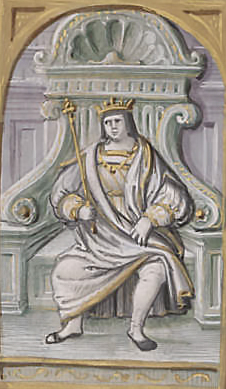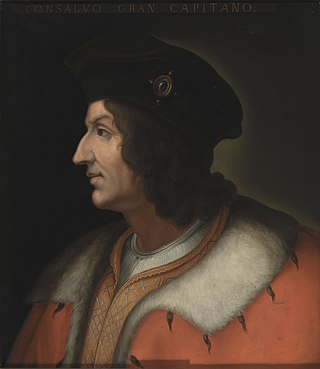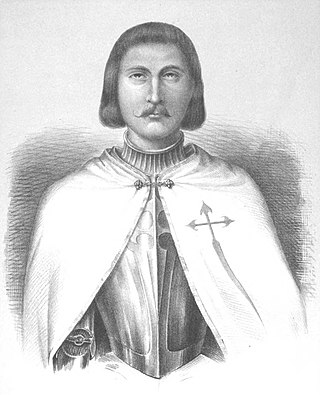
Henry III of Castile, called the Suffering due to his ill health, was the son of John I and Eleanor of Aragon. He succeeded his father as King of Castile in 1390.

Henry II, called Henry of Trastámara or the Fratricidal, was the first King of Castile and León from the House of Trastámara. He became king in 1369 by defeating his half-brother Peter the Cruel, after numerous rebellions and battles. As king he was involved in the Fernandine Wars and the Hundred Years' War.

Gonzalo Fernández de Córdoba was a Spanish general and statesman. He led military campaigns during the Conquest of Granada and the Italian Wars, after which he served as Viceroy of Naples. For his extensive political and military success, he was made Duke of Santángelo (1497), Terranova (1502), Andría, Montalto and Sessa (1507), and earned the nickname El Gran Capitán.
Diego Fernández de Córdoba may refer to:

Gonzalo Fernández de Córdoba y Cardona-Anglesola was one of the main Spanish military leaders during the Eighty Years' War, Thirty Years' War, and the War of the Mantuan Succession.

Cabra is a municipality in Córdoba province, Andalusia, Spain and the site of former bishopric Egabro. It lies along the route between Córdoba and Málaga in the south of Spain. It is an entrance point to the Parque Natural de las Sierras Subbéticas.

Aguilar, or in full Aguilar de la Frontera, is a municipality and town in the province of Córdoba, Andalusia, southern Spain, near the small river Cabra, 50 kilometres (31 mi) from the provincial capital, Córdoba, on the Córdoba-Málaga railway. As Ancient Ipagro, it also was an Ancient/medieval bishopric and remains a Latin Catholic titular see.

Beltrán de la Cueva y Alfonso de Mercado, 1st Duke of Alburquerque was a Spanish nobleman who is said to have fathered Joanna, the daughter of Henry IV of Castile's wife Joan of Portugal. His alleged daughter, called "la Beltraneja", was deprived of the crown of Castile because of the uncertainty regarding her parentage.

Don Diego Hurtado de Mendoza y Figueroa, 1st Duke of the Infantado, or Diego Hurtado de Mendoza y Suarez de Figueroa was a Spanish noble.
Antonio Fernández de Córdoba y Cardona, 5th Duke of Sessa, was a Spanish nobleman. He held the titles of Duke of Sessa, Duke of Soma, and Duke of Baena, among others.
Diego Fernández de Córdoba y Arellano, 1st Marquis of Comares,, invested 1st marquis of Comares in 1512, was Governor of Oran and Mazalquivir, 1509–1512 and 1516–1518, and first Viceroy of Navarre, 1512–1515.

Gonzalo II Fernández de Córdoba, third Duke of Sessa, was the grandson of a Viceroy of Naples, Gonzalo Fernández de Córdoba, first duke of Sessa, the son of the first duke's daughter, Elvira Fernández de Córdoba y Manrique, and of her husband, Luis Fernández de Córdoba. Gonzalo II, holder of several dukedoms and many other lesser titles, Spanish and Italian, was Captain General of the Spanish Troops in Italy, Great Admiral of the Kingdom of Naples, and a member of the Spanish king Royal Council for Italy and the Royal War Council.
Martín Alonso Fernández de Córdoba Montemayor y Velasco was a Spanish nobleman, first Count of Alcaudete, Viceroy of Navarra, and governor of Oran.

Marquess of Villena is a hereditary title in the Peerage of Spain, granted in 1445 by John II to Juan Pacheco, Grand Master of the Order of Santiago and later also 1st Duke of Escalona.

Alonso de Fonseca y Acevedo was a Roman Catholic prelate who served as Archbishop of Santiago de Compostela, and Archbishop of Seville (1465–1469).

The Battle of Lucena, also called Battle of Martín González, was a war event in which Christian forces of the Crown of Castile were faced against the Muslim forces of the Nasrid Emirate of Granada. It took place in the month of April of the year 1483, in the course of the Granada War, and in the course of it the Christian forces took Muhammad XII of Granada prisoner.
Diego Rodríguez de Lucero was a priest and inquisitor of the Kingdom of Castile based in Córdoba between 1499 and 1507. His harsh and unjust persecutions created a reign of terror, and eventually he was removed from office.
Diego Fernández de Córdoba y Mendoza, 3rd Count of Cabra, was a Castilian nobleman. He served with distinction during the war in which the Emirate of Granada was conquered by the forces of Castile and Aragon, and subsequently had great influence in Castile.

Pedro Fernández de Córdoba y Pacheco, first Marquess of Priego, was a Castilian nobleman. He became one of the most powerful men in Andalusia, but after the death of Queen Isabella I of Castile (1451–1504), he supported her daughter Joanna of Castile (1479–1555) against King Ferdinand II of Aragon (1452–1516), who was regent of Castile. After serious disturbances in Córdoba in 1508 he was forced to throw himself on the king's mercy, and was arrested and exiled. Later he was pardoned and allowed to return.
Luis Fernández de Córdoba was a Spanish nobleman, count of Cabra and viscount of Iznájar, lord of the house of Baena, Duke of Sessa, of Terranova and of Santángelo by his marriage to his cousin, Elvira Fernández de Córdoba y Manrique . Luis was the son of Diego Fernández de Córdoba y Mendoza, third count of Cabra and Francisca de Zúñiga y de la Cerda.














